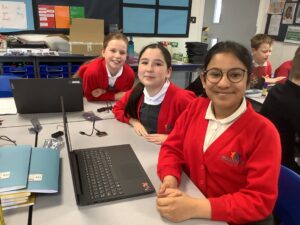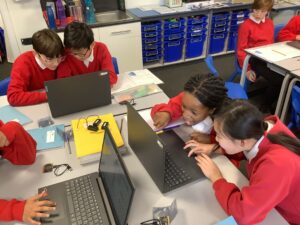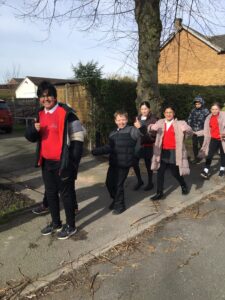Living and Learning: Fire Safety
Year 5 had some firefighters come in to talk to us about fire safety. We discussed how to keep safe before and if there is an event of a fire:
before
- keep the doors closed for all rooms before you go to bed at night
- do not charge electrical devices overnight or on a soft surface
- keep your keys for the front door in a safe place between the bedroom and door (in case you need to leave quickly)
- turn electrical items off at the switch not just on standby
if there is a fire
- ring 999 and ask for the fire service
- if stuck in your room, shout for your adults or help from out the window
- do not jump out a window unless absolutely necessary
We were then able to go and take a look at the fire engine and even squirt some water from the hose!








Help at home: Discuss the safe route out of your house in case there is a fire. Check your smoke alarms regularly.
Computing with micro:bits!
This week, we started our online computing learning. The excitement in the room was PALPABLE!
We’re using micro:bits…


…tiny computers that you can program to do a virtually unlimited number of awesome things!
This linked to simulation (one of our computing words) because the makecode website where you program the micro:bit has an ‘emulator’. This shows you what your code will do once it’s been downloaded to your physical micro:bit.







Once we were finished exploring, it was time to download the code and see it in action! We made it say hello to us, or show a heart or play a tune when you pressed a certain button.


We are so looking forward to the rest of the topic!
Help at home by asking your child about our computing words: repetition, internet, simulation, World Wide Web, computer network, variable and selection.
World Book Day tomorrow!
Tomorrow is World Book Day! World Book Day encourages more children and families to find the fun and enjoyment in reading, because reading for pleasure changes lives.
Read more here: https://www.worldbookday.com/about-us/
As part of World Book Day, I would like the children to bring in their favourite books tomorrow! We’ll have time to share and discuss their books which will give the rest of the class inspiration for their next book to read.
I look forward to hearing about them!
Thanks, Miss Birch
Bring in your favourite book!
On Thursday (5th March 2025), it is World Book Day! We have a very exciting day planned filled with lots of brilliant activities all about reading.
As part of our day, we’ll be exploring and discussing our favourite books so it would be great if your children could bring in their favourite book on Thursday to discuss with their peers. They’ll be sharing what they love about their book in hope to inspire others to read it too. Your children will also have the chance to read some in front of the class.
I’m looking forward to hearing all about your children’s favourite books and authors!
Our letters are on their way!
Today, we finally were able to venture out to our local post box to post our letters to Steve Reed, the environment minister, about stopping climate change. It was very exciting!






There were big cheers as the letter went in!




You’re never too small to create a big change. All it starts with is a single step! (Or quite a few to the nearest post box.)
“The atmosphere was electric! Everybody had loads of fun,” Vivienne described.
“I hope our letters can persuade Steve Reed to do something about climate change and if it does, this is great example of small things, big changes,” beamed Grace.
Jack said: “Everybody was so enthusiastic about writing their letters. We finished them so fast because we were so excited!”
“We had a great time posting the letters. Miss Wilson gave us a motivational message about it not mattering how small you are, you can always change the world a little bit,” said Hidayah.
Raheem explained, “We had a democratic vote about who should put the letter in the post box.”
Leeds Rhinos healthy lifestyle assembly and ticket offer
This week, we welcomed Luke from Leeds Rhinos to deliver a healthy lifestyle assembly.
We thought about different aspects of keeping a healthy lifestyle including food and nutrition, sleep, exercise, hydration and hygiene.
Luke also spoke about the ticket offer available for families for one of the upcoming Leeds Rhinos home games.

As part of our partnership, and as a reward for all the great work that the children have been doing this year, Leeds Rhinos would like to offer children and their families an amazing opportunity to attend a match at AMT Headingley Stadium (LS6 3BR) at a special discounted schools rate.
Date – Saturday 22nd March 2025
Kick off – 5:30pm
Opposition – Wigan Warriors
Standing tickets can be booked now through the school via School Gateway. Please note that tickets will be on sale until 10am on Tuesday 18th March.
World Book Day
This Thursday is World Book Day where we celebrate books and reading.
Today, we joined an online talk from the illustrator, David O’Connell.
First, we learnt some bugs facts based on the living things in his books.

Then, David showed us how to draw three of his characters, Dribble, Dash and Nettie, taken from his latest book, The Beastie Bros. The children’s illustrations were excellent.





Finally, there was chance to think about what questions we’d like to ask David.
How many books have you wrote?
What was your first book called?
Why did you want to become an illustrator and author?
Help at home: have a look at some illustrations in books at home. How are they similar or different to the characters David draws?
Term 2.2 – group reading!
Hello!
Last week, we began group reading!
The class have been divided into groups and each group has been given a book to read at home. This will last for this half term.
During our Book Club sessions each Friday, each group will discuss what they have read so far and share their reading record activities related to their book. This will be a fantastic opportunity for the children to explore characters and storylines more than they might do normally!
Every Friday during Book Club, each group will be given a new page to read to for the next Friday.
What to remember:
- Your child has a book that they need to read every week (up to a chosen point marked with a post-it notes).
- The reading record activity needs to be completed using their new book.
- A comment from a grown up needs to be written in their reading record.
- Group reading books and reading records need to be brought in every Friday.
Help at home by listening to your child read their new book and asking them questions about the book to help prepare them for class discussions.
I look forward to hearing the children’s discussions next week!
Thanks, Miss Birch
Reminder: World Book Day
World Book Day- 06.03.24
Living and Learning: MindMate
This half term our Living and Learning lessons are based around the MindMate learning themes of emotions and friendships.

Our first lesson was based around strong emotions and exploring and describing how it feels to be sad/unhappy.
We thought about how others might express feelings of unhappiness and if they did feel unhappy, to practise asking, and listening to, others about what makes them unhappy.
We reinforced that everyone feels sad or unhappy at times and that’s natural.
In our circle time, on the same theme, the children suggested some things to do if they were feeling sad.
Would it help if…
- you walked away from the situation making you sad
- you talked to a friend or a trusted adult
- you wrote down how you felt
- you read a book
- you went for a walk
- you did some exercise like dancing
As part of this lesson, we did two of the mindfulness exercises taken from this website – mindful hearing and mindful breathing.
Help at home – ask your child what they might do if they were feeling unhappy or if a friend was feeling unhappy.